Abstract
An NADPH-specific disulfide reductase that is active with bis-gamma-glutamylcystine has been purified 1,900-fold from Halobacterium halobium to yield a homogeneous preparation of the enzyme. Purification of this novel reductase, designated bis-gamma-glutamylcystine reductase (GCR), and purification of halobacterial dihydrolipoamide dehydrogenase (DLD) were accomplished with the aid of immobilized-metal-ion affinity chromatography in high-salt buffers. Chromatography of GCR on immobilized Cu2+ resin in buffer containing 1.23 M (NH4)2SO4 and on immobilized Ni2+ resin in buffer containing 4.0 M NaCl together effected a 120-fold increase in purity. Native GCR was found to be a dimeric flavoprotein of Mr 122,000 and to be more stable to heat when in buffer of very high ionic strength. DLD was chromatographed on columns of immobilized Cu2+ resin in buffer containing NaCl and in buffer containing (NH4)2SO4, the elution of DLD differing markedly in the two buffers. Purified DLD was found to be a heat-stable, dimeric flavoprotein of Mr 120,000 and to be very specific for NAD. The utility of immobilized-metal-ion affinity chromatography for the purification of halobacterial enzymes and the likely cellular function of GCR are discussed.
Full text
PDF
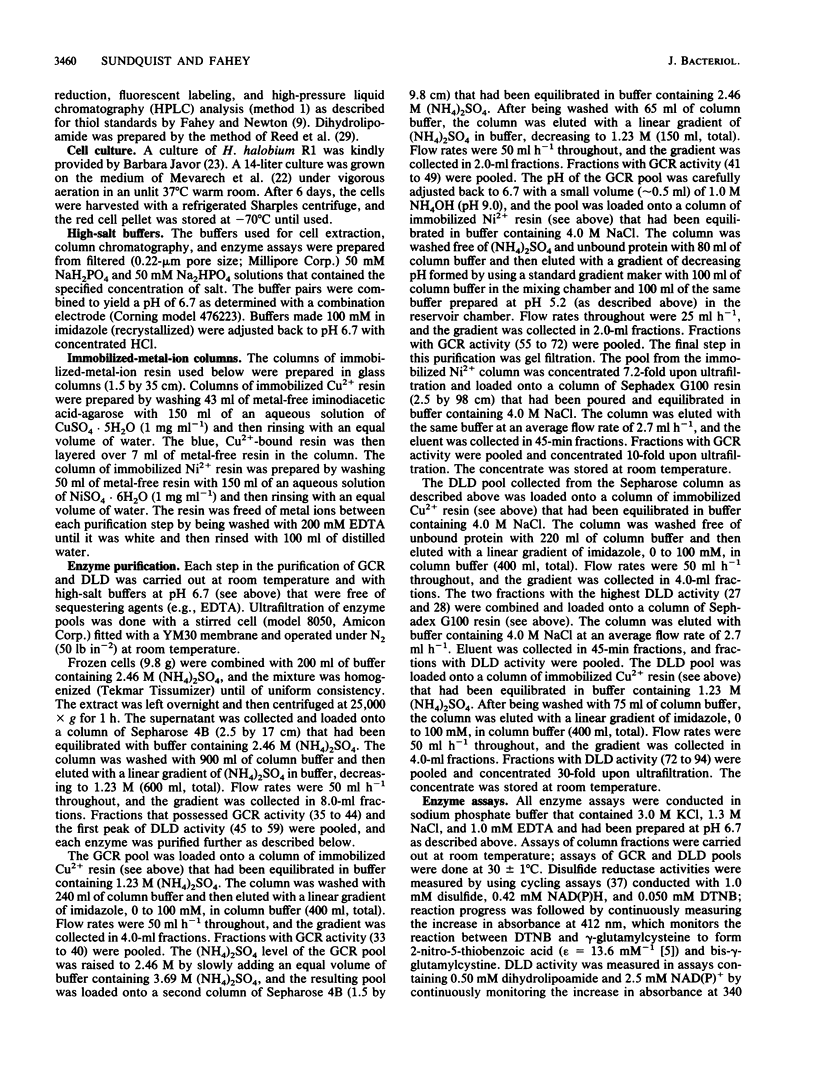
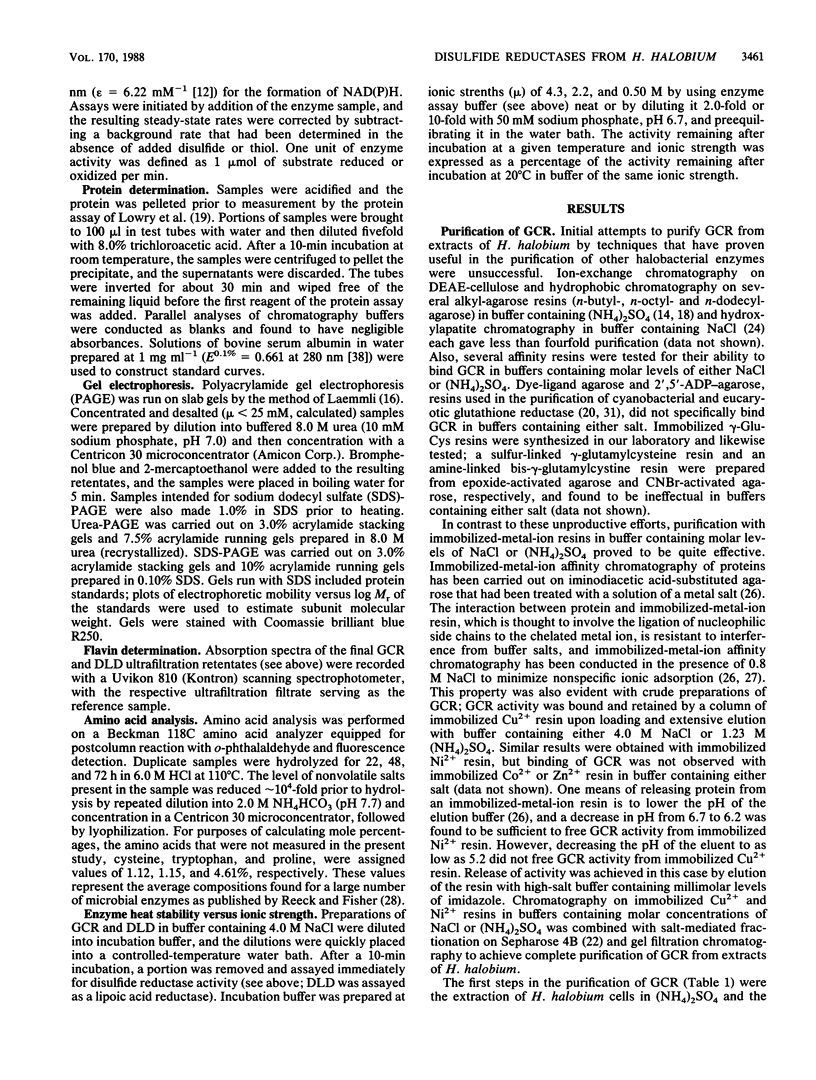
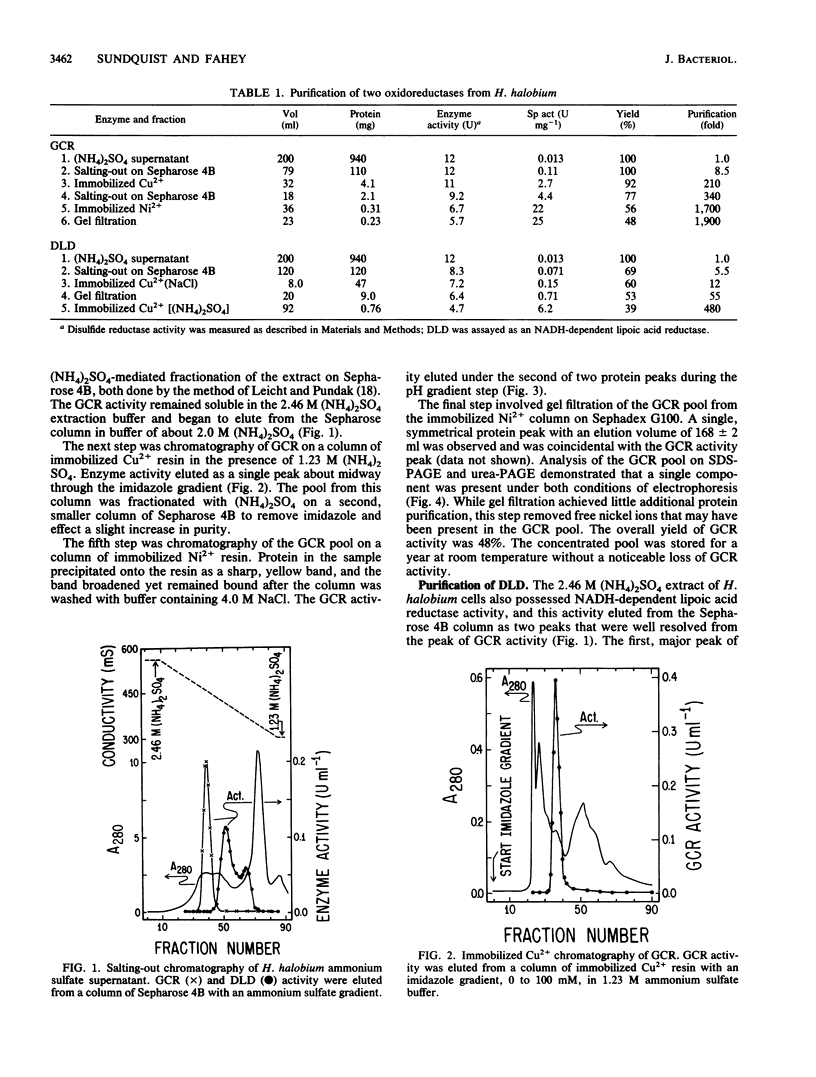
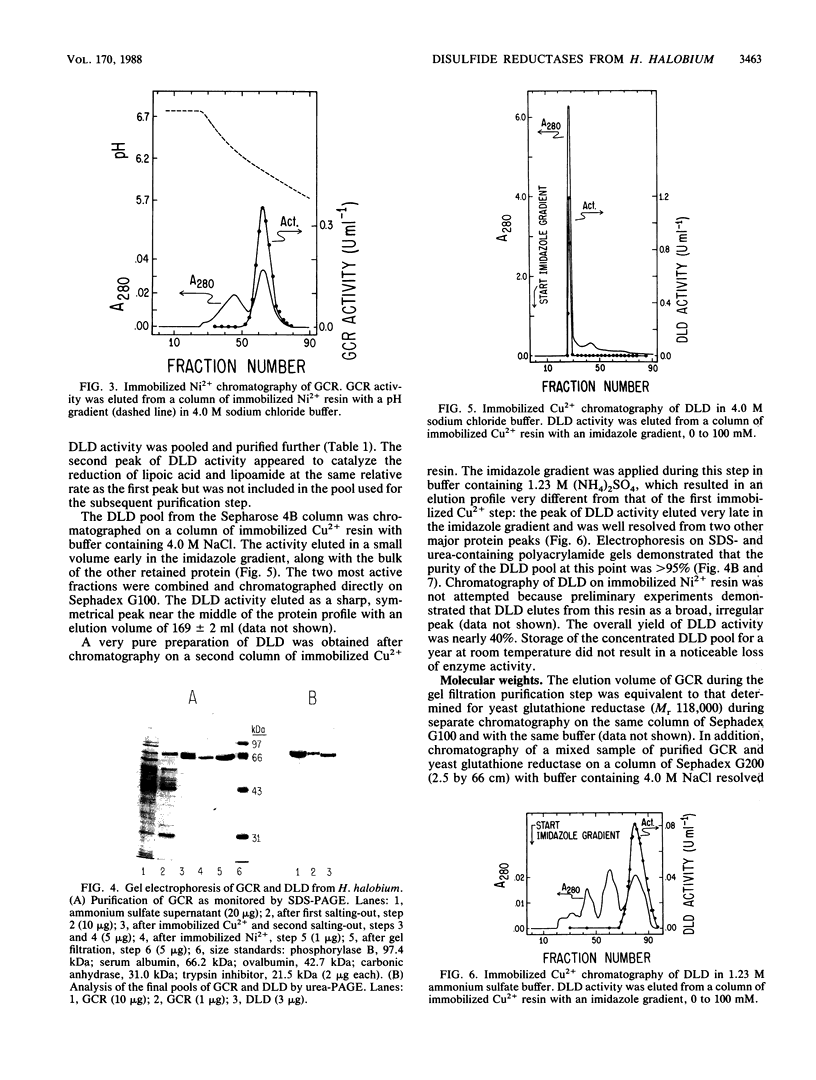

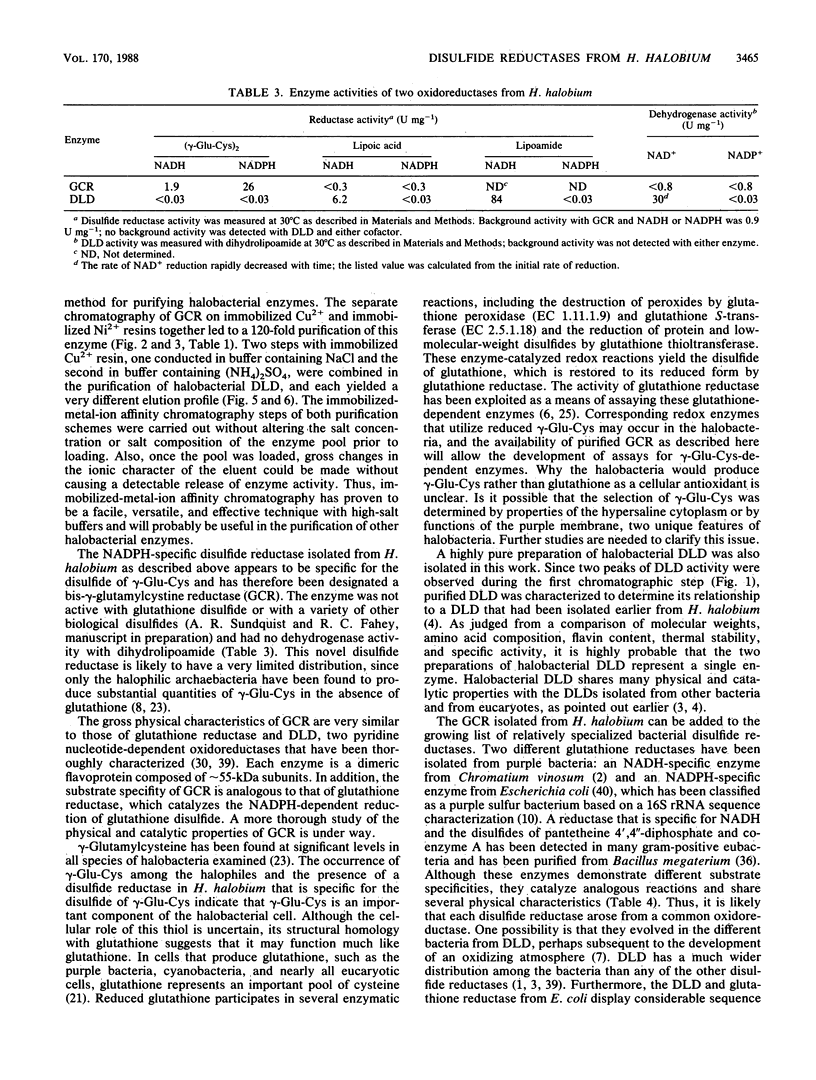


Images in this article
Selected References
These references are in PubMed. This may not be the complete list of references from this article.
- Chung Y. C., Hurlbert R. E. Purification and properties of the glutathione reductase of Chromatium vinosum. J Bacteriol. 1975 Jul;123(1):203–211. doi: 10.1128/jb.123.1.203-211.1975. [DOI] [PMC free article] [PubMed] [Google Scholar]
- Danson M. J., Eisenthal R., Hall S., Kessell S. R., Williams D. L. Dihydrolipoamide dehydrogenase from halophilic archaebacteria. Biochem J. 1984 Mar 15;218(3):811–818. doi: 10.1042/bj2180811. [DOI] [PMC free article] [PubMed] [Google Scholar]
- ELLMAN G. L. Tissue sulfhydryl groups. Arch Biochem Biophys. 1959 May;82(1):70–77. doi: 10.1016/0003-9861(59)90090-6. [DOI] [PubMed] [Google Scholar]
- Eriksson S., Askelöf P., Axelsson K., Carlberg I., Guthenberg C., Mannervik B. Resolution of glutathione-linked enzymes in rat liver and evaluation of their contribution to disulfide reduction via thiol--disulfide interchange. Acta Chem Scand B. 1974;28(8):922–930. doi: 10.3891/acta.chem.scand.28b-0922. [DOI] [PubMed] [Google Scholar]
- Fahey R. C., Buschbacher R. M., Newton G. L. The evolution of glutathione metabolism in phototrophic microorganisms. J Mol Evol. 1987;25:81–88. doi: 10.1007/BF02100044. [DOI] [PubMed] [Google Scholar]
- Fahey R. C., Newton G. L. Determination of low-molecular-weight thiols using monobromobimane fluorescent labeling and high-performance liquid chromatography. Methods Enzymol. 1987;143:85–96. doi: 10.1016/0076-6879(87)43016-4. [DOI] [PubMed] [Google Scholar]
- Fox G. E., Stackebrandt E., Hespell R. B., Gibson J., Maniloff J., Dyer T. A., Wolfe R. S., Balch W. E., Tanner R. S., Magrum L. J. The phylogeny of prokaryotes. Science. 1980 Jul 25;209(4455):457–463. doi: 10.1126/science.6771870. [DOI] [PubMed] [Google Scholar]
- Greer S., Perham R. N. Glutathione reductase from Escherichia coli: cloning and sequence analysis of the gene and relationship to other flavoprotein disulfide oxidoreductases. Biochemistry. 1986 May 6;25(9):2736–2742. doi: 10.1021/bi00357a069. [DOI] [PubMed] [Google Scholar]
- Keradjopoulos D., Holldorf A. W. Purification and properties of alanine dehydrogenase from Halobacterium salinarium. Biochim Biophys Acta. 1979 Sep 12;570(1):1–10. doi: 10.1016/0005-2744(79)90195-5. [DOI] [PubMed] [Google Scholar]
- Kosower N. S., Kosower E. M. The glutathione status of cells. Int Rev Cytol. 1978;54:109–160. doi: 10.1016/s0074-7696(08)60166-7. [DOI] [PubMed] [Google Scholar]
- LOWRY O. H., ROSEBROUGH N. J., FARR A. L., RANDALL R. J. Protein measurement with the Folin phenol reagent. J Biol Chem. 1951 Nov;193(1):265–275. [PubMed] [Google Scholar]
- Laemmli U. K. Cleavage of structural proteins during the assembly of the head of bacteriophage T4. Nature. 1970 Aug 15;227(5259):680–685. doi: 10.1038/227680a0. [DOI] [PubMed] [Google Scholar]
- Lanyi J. K. Salt-dependent properties of proteins from extremely halophilic bacteria. Bacteriol Rev. 1974 Sep;38(3):272–290. doi: 10.1128/br.38.3.272-290.1974. [DOI] [PMC free article] [PubMed] [Google Scholar]
- Leicht W., Pundak S. Large-scale purification of halophilic enzymes by salting-out mediated chromatography. Anal Biochem. 1981 Jun;114(1):186–192. doi: 10.1016/0003-2697(81)90472-3. [DOI] [PubMed] [Google Scholar]
- Mannervik B., Jacobbson K., Boggaram V. Purification of glutathione reductase from erythrocytes by the use of affinity chromatography on 2', 5'-ADP-Sepharose 4-B. FEBS Lett. 1976 Jul 15;66(2):221–224. doi: 10.1016/0014-5793(76)80508-x. [DOI] [PubMed] [Google Scholar]
- Meister A., Anderson M. E. Glutathione. Annu Rev Biochem. 1983;52:711–760. doi: 10.1146/annurev.bi.52.070183.003431. [DOI] [PubMed] [Google Scholar]
- Mevarech M., Leicht W., Werber M. M. Hydrophobic chromatography and fractionation of enzymes from extremely halophilic bacteria using decreasing concentration gradients of ammonium sulfate. Biochemistry. 1976 Jun 1;15(11):2383–2387. doi: 10.1021/bi00656a021. [DOI] [PubMed] [Google Scholar]
- Newton G. L., Javor B. gamma-Glutamylcysteine and thiosulfate are the major low-molecular-weight thiols in halobacteria. J Bacteriol. 1985 Jan;161(1):438–441. doi: 10.1128/jb.161.1.438-441.1985. [DOI] [PMC free article] [PubMed] [Google Scholar]
- Norberg P., von Hofsten B. Chromatography of a halophilic enzyme on hydroxylapatite in 3.4 M sodium chloride. Biochim Biophys Acta. 1970 Oct 14;220(1):132–133. doi: 10.1016/0005-2744(70)90239-1. [DOI] [PubMed] [Google Scholar]
- Paglia D. E., Valentine W. N. Studies on the quantitative and qualitative characterization of erythrocyte glutathione peroxidase. J Lab Clin Med. 1967 Jul;70(1):158–169. [PubMed] [Google Scholar]
- Porath J., Carlsson J., Olsson I., Belfrage G. Metal chelate affinity chromatography, a new approach to protein fractionation. Nature. 1975 Dec 18;258(5536):598–599. doi: 10.1038/258598a0. [DOI] [PubMed] [Google Scholar]
- Porath J., Olin B. Immobilized metal ion affinity adsorption and immobilized metal ion affinity chromatography of biomaterials. Serum protein affinities for gel-immobilized iron and nickel ions. Biochemistry. 1983 Mar 29;22(7):1621–1630. doi: 10.1021/bi00276a015. [DOI] [PubMed] [Google Scholar]
- REED L. J., KOIKE M., LEVITCH M. E., LEACH F. R. Studies on the nature and reactions of protein-bound lipoic acid. J Biol Chem. 1958 May;232(1):143–158. [PubMed] [Google Scholar]
- Reeck G. R., Fisher L. A statistical analysis of the amino acid compositions of proteins. Int J Pept Protein Res. 1973;5(2):109–117. doi: 10.1111/j.1399-3011.1973.tb02325.x. [DOI] [PubMed] [Google Scholar]
- Rice D. W., Schulz G. E., Guest J. R. Structural relationship between glutathione reductase and lipoamide dehydrogenase. J Mol Biol. 1984 Apr 15;174(3):483–496. doi: 10.1016/0022-2836(84)90332-2. [DOI] [PubMed] [Google Scholar]
- Serrano A., Rivas J., Losada M. Purification and properties of glutathione reductase from the cyanobacterium Anabaena sp. strain 7119. J Bacteriol. 1984 Apr;158(1):317–324. doi: 10.1128/jb.158.1.317-324.1984. [DOI] [PMC free article] [PubMed] [Google Scholar]
- Swerdlow R. D., Green C. L., Setlow B., Setlow P. Identification of an NADH-linked disulfide reductase from Bacillus megaterium specific for disulfides containing pantethine 4',4''-diphosphate moieties. J Biol Chem. 1979 Aug 10;254(15):6835–6837. [PubMed] [Google Scholar]
- Swerdlow R. D., Setlow P. Purification and characterization of a Bacillus megaterium disulfide reductase specific for disulfides containing pantethine 4',4"-diphosphate. J Bacteriol. 1983 Jan;153(1):475–484. doi: 10.1128/jb.153.1.475-484.1983. [DOI] [PMC free article] [PubMed] [Google Scholar]
- Tietze F. Enzymic method for quantitative determination of nanogram amounts of total and oxidized glutathione: applications to mammalian blood and other tissues. Anal Biochem. 1969 Mar;27(3):502–522. doi: 10.1016/0003-2697(69)90064-5. [DOI] [PubMed] [Google Scholar]




